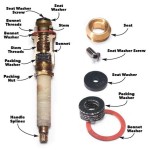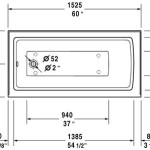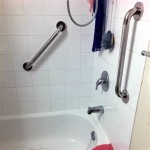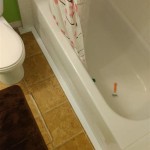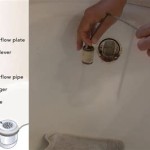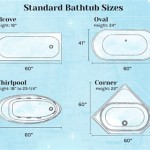What Are The Parts Of A Bathtub?
Bathtubs are a common fixture in many bathrooms, providing a space for personal hygiene and relaxation. While the core function of a bathtub remains consistent, understanding its component parts is beneficial for maintenance, repairs, or even when selecting a new bathtub. This article will comprehensively outline the various parts of a bathtub, describing their function and significance.
The Bathtub Shell
The bathtub shell is the primary and most substantial component, forming the basin that holds the water. It is typically manufactured from various materials, with acrylic, fiberglass, cast iron, and steel being the most common. The shell's material influences the bathtub's durability, heat retention properties, weight, and cost.
Acrylic bathtubs are known for their lightweight construction and ability to retain heat relatively well. They are manufactured by heating a sheet of acrylic and molding it over a form. Fiberglass reinforcement is then typically applied to provide structural support. Acrylic is also non-porous, making it relatively easy to clean and resistant to stains.
Fiberglass bathtubs are another lightweight and affordable option. However, fiberglass alone is not very durable and tends to flex under weight. Therefore, fiberglass bathtubs are almost always coated with a layer of gel coat for waterproofing and improved durability. While more affordable than other materials, fiberglass bathtubs are more prone to scratches and cracks.
Cast iron bathtubs are renowned for their exceptional durability and heat retention capabilities. They are created by pouring molten iron into a mold. Once cooled, the cast iron is coated with enamel, providing a smooth, durable, and resistant surface. Cast iron bathtubs are significantly heavier than acrylic or fiberglass models, requiring greater structural support in the bathroom.
Steel bathtubs offer a compromise between weight and durability. They consist of a steel shell coated with porcelain enamel. While lighter than cast iron, steel bathtubs are still more robust than acrylic or fiberglass options. The porcelain enamel provides a smooth, scratch-resistant surface, although it can be prone to chipping if subjected to heavy impact.
The shape of the bathtub shell also varies. Standard rectangular tubs are common, but other options include oval, corner, and freestanding tubs. The shape influences the tub's aesthetic appeal and the amount of space it occupies in the bathroom.
The Drain Assembly
The drain assembly is a critical component responsible for removing water from the bathtub. It consists of several interconnected parts working in concert to prevent leaks and ensure efficient drainage.
The drain flange is the visible part of the drain that sits inside the bathtub. It usually has a strainer to catch hair and debris, preventing them from clogging the drainpipe. The flange is connected to the drain elbow, which is located beneath the bathtub. The drain elbow is a curved pipe that directs the water flow towards the drainpipe.
The drainpipe connects the drain elbow to the plumbing system, channeling the wastewater away from the bathtub. The drainpipe is usually made of PVC or metal and must be properly sealed to prevent leaks. The type of drain mechanism, either pop-up or lift-and-turn, dictates how the drain is opened and closed. A pop-up drain is activated by a lever or button, while a lift-and-turn drain requires the user to manually lift and turn the drain stopper.
The overflow drain is an important safety feature, preventing the bathtub from overflowing. It is typically located near the top of the bathtub, just below the rim. The overflow drain is connected to a pipe that leads to the drainpipe, allowing excess water to drain away before reaching the rim. The overflow drain usually includes a cover plate, which may be decorative or functional, such as including a trip lever for the pop-up drain mechanism.
The Faucet and Water Supply
The faucet and associated water supply components control the flow and temperature of the water entering the bathtub. The faucet itself is the fixture that dispenses water and often includes separate hot and cold water handles or a single lever for mixing the water.
The faucet body houses the internal mechanisms that control the water flow. These mechanisms may include cartridges, compression valves, or ball valves, depending on the faucet type. The faucet body is connected to the water supply lines, which deliver hot and cold water to the faucet.
The water supply lines are typically made of copper, PEX, or flexible braided stainless steel. They connect to the shut-off valves, which allow the water supply to the faucet to be turned off for maintenance or repairs. The shut-off valves are essential for preventing water damage during these procedures.
The spout is the part of the faucet that extends over the bathtub and dispenses the water. The spout may be fixed in place or have a diverter that allows water to be redirected to a showerhead, if present. The type of spout can vary in design, from simple curved shapes to more elaborate, decorative styles.
Supporting Structures and Optional Features
Beyond the essential components of the shell, drain, and faucet, several supporting structures and optional features can enhance the functionality and aesthetics of a bathtub.
The bathtub frame provides structural support for the bathtub shell. This is particularly important for freestanding bathtubs, which do not rely on surrounding walls for support. The frame may be made of wood, metal, or a composite material, and it must be strong enough to support the weight of the bathtub filled with water and a person.
The apron is the decorative panel that covers the front of the bathtub, concealing the drain and plumbing connections. Aprons are typically made of the same material as the bathtub shell and can be removed for access to the plumbing behind the bathtub. The apron provides a finished look and protects the plumbing from damage.
Some bathtubs include features such as jets for hydrotherapy, air bubbles for a gentle massage, or built-in heaters to maintain water temperature. These features add to the cost and complexity of the bathtub but can significantly enhance the bathing experience. Whirlpool jets circulate water, while air bubbles provide a gentler massage. Built-in heaters are particularly desirable for longer soaking sessions.
Grab bars are safety features that can be installed on the walls surrounding the bathtub. They provide a secure handhold for entering and exiting the bathtub, reducing the risk of slips and falls. Grab bars are especially important for individuals with mobility issues.
Bathtub surrounds are wall panels that protect the walls surrounding the bathtub from water damage. They are typically made of acrylic, fiberglass, or tile and can be installed as a single unit or as individual panels. Bathtub surrounds provide a waterproof barrier and are easier to clean than painted walls.
Bathtub pillows provide neck and head support for relaxed bathing. They come in various shapes and materials, often attaching to the bathtub with suction cups. They can significantly increase comfort during long baths.
In conclusion, understanding the various parts of a bathtub is essential for proper maintenance, repairs, and informed purchasing decisions. Each component plays a vital role in the functionality and longevity of the bathtub, from the shell that holds the water to the drain assembly that removes it and the faucet that controls its flow. By familiarizing oneself with these components, one can better appreciate the intricacies of this common bathroom fixture.

Bathtub Parts Everyone Should Know About Part Names 2024

Choosing A Bathtub Everything You Need To Know Rona

Parts Of A Bathtub With Diagram Homenish

Ultimate Guide On 24 Parts Of A Bathtub Names Functions Diagram

Fancy Jetted Tub Controls Photos And Plumbing Parts Diagram Inside Cute Images The Best Bathroom Ideas Lapoupm On Euroettecom Photograph 43 Mti Manual

Drain Kit Bathtub Shower Parts At Com

The Diffe Parts Of A Bathtub And How They Work Family Handyman

Bathtub Plumbing Installation Drain Diagrams Edmond Refinishing

What Parts Does A Bathtub Shower System Consist Of Wellfor

How A Bathtub Works Types Plumbing Diagrams Hometips

